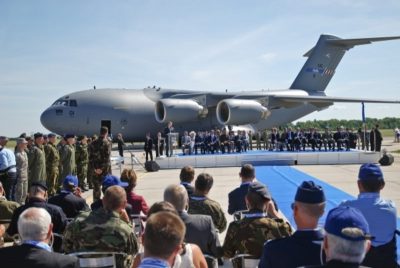Pentagon Gains Two New Air Bases in Hungary

All Global Research articles can be read in 51 languages by activating the “Translate Website” drop down menu on the top banner of our home page (Desktop version).
Visit and follow us on Instagram at @crg_globalresearch.
***
U.S. European Command (EUCOM) and officials from the Hungarian Defense Force met at the Kecskemét Air Base in Hungary on July 16 to sign an agreement allowing the U.S. assess to and use of two air bases in the country. The bases are the one the agreement was signed at and the Pápa Air Base.
Army Major General Charles Miller, EUCOM’s director of plans, policy, strategy and capabilities, was quoted by his command’s website as stating:
“These agreements allow U.S. forces to access and utilize these air bases in cooperation with the Hungarian Defence Force.” Indicating that securing the bases is not the final stage in bilateral military cooperation, he added, “This signing brings with it new opportunities for even greater collaboration and coordination with our Hungarian Allies.”
The agreement was reached under provisions of the 2019 Defense Cooperation Agreement between the U.S. and Hungary. Similar pacts have been signed with most former members of the long-defunct Warsaw Pact to provide air bases to the U.S. and NATO since 2004. A partial list of such bases will follow.
The American chargé d’dffaires in Budapest, Marc Dillard, affirmed:
“This signing demonstrates that the Defense Cooperation Agreement continues to deepen our already robust collective defense cooperation as NATO Allies and helps us prepare for the 21st century security challenges we face together.”
After Hungary joined the military alliance in 1999 the Pápa Air Base was declared a NATO reserve base. It was designated a Main Operating Base and hosted three NATO Strategic Airlift Capability aircraft from 2007 onward.
In 2020 the NATO Support and Procurement Agency completed a project to modernise components of the base. It has hosted C-17 Globemaster III long-range cargo jets as the Heavy Airlift Wing facet of the 12-nation multinational Strategic Airlift Capability, the world’s first multinational strategic airlift operation. Its partners at the time it achieved full operational capability in 2012 were NATO members Hungary, Bulgaria, Estonia, Lithuania, the Netherlands, Norway, Poland, Romania, Slovenia and the U.S., as well as (now) NATO Enhanced Opportunities Partners Finland and Sweden. The base and the operation were used extensively for NATO’s war in Afghanistan.
With the acquisition of the two Hungarian bases the U.S, and NATO (they’re truly indistinguishable) have now moved into several air bases in former Warsaw Pact countries since the first round of post-Cold War NATO expansion in 1999.
They include:
- Bulgaria: Bezmer Air Base and Graf Ignatievo Air Base
- Estonia: Ämari Air Base
- Hungary: Kecskemét Air Base and Pápa Air Base
- Lithuania: Šiauliai Air Base
- Poland: Łask Air Base and Malbork Air Base
- Romania: Deveselu Air Base, Mihail Kogălniceanu International Airport and Romanian Air Force 71st Air Base at Câmpia Turzii.
The Deveselu Air Base in Romania was reopened by the U.S. and NATO and now hosts Standard Missile-3 interceptor missiles directly across the Black Sea from Russia. All have been expanding and modernized.
The air force component of NATO’s military buildup along what the military alliance terms its Eastern Flank – which is Russia’s western border – is constantly advancing. Someone in Moscow should be getting the message by now.
*
Note to readers: Please click the share buttons above or below. Follow us on Instagram, @crg_globalresearch. Forward this article to your email lists. Crosspost on your blog site, internet forums. etc.
Rick Rozoff, renowned author and geopolitical analyst, actively involved in opposing war, militarism and interventionism for over fifty years. He manages the Anti-Bellum and For peace, against war website
He is a Research Associate of the Centre for Research on Globalization.
Featured image: First Boeing C-17 Globemaster III lands at the Pápa Air Base in 2009 (Source: Anti-bellum)

